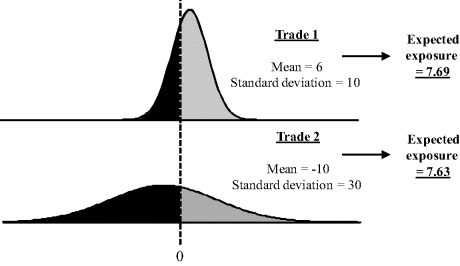9.6 Allocating Exposure
It is clear from the above examples that netting benefits can be substantial. It is not clear though how to allocate these benefits to the individual trades. If the EE (or PFE) of the trades is considered on a stand-alone basis then this will overstate the actual risk. However, there is no single way to distribute the netted exposure amongst the trades.
9.6.1 Simple Two-Trade, Single-Period Example
Suppose we have two exposures defined by normal distributions with different mean and standard deviation as illustrated in Figure 9.13. The distributions are rather different, the first having a positive mean and a smaller standard deviation and the second a negative mean but a larger standard deviation. The result of this is that the EEs are similar at 7.69 and 7.6313 for trade 1 and trade 2, respectively. Assuming zero correlation, the total expected exposure of both trades would be 10.72.14
Figure 9.13 Distribution defining the exposures for the simple example.

Now the question is how to allocate the exposure of 10.72 between the two trades. The most obvious way to do this is to ask simply in which order they arose. If trade 1 was first then by definition it would contribute an EE of 7.69 at that time. By a simple subtraction, trade 2 would then have to represent only 3.03. If the order were reversed then the numbers would be almost the opposite. We will refer ...
Get Counterparty Credit Risk and Credit Value Adjustment: A Continuing Challenge for Global Financial Markets, 2nd Edition now with the O’Reilly learning platform.
O’Reilly members experience books, live events, courses curated by job role, and more from O’Reilly and nearly 200 top publishers.

